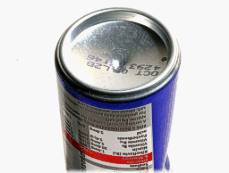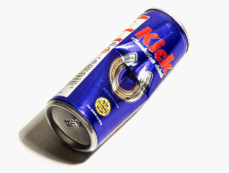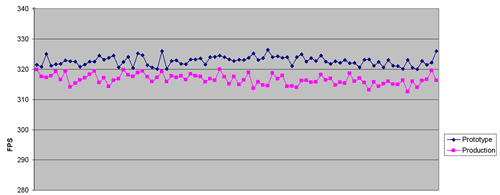Tests Differences between TM and CA version? So what is different between the Classic Army AEG and the TM version? Here are some shots of the TM G36C for reference which are courtesy of Jonathan Marmand (aka Space Cowboy): Power/performance - Factory specs from Classic Army quote the output power of the CA36C being in the range of 85-95 m/sec (280.5 - 313.5 fps) using 0.2g BBs slightly over the 280 fps standard produced by TM. Oh, before I forget the CA barrel is a standard 6.08mm ID unit, so there's room to fit a tighter barrel if you're looking for a bit more accuracy over a standard barrel. CA wires not as tidy - Every TM rifle I've ever looked at always has wires that are quite tidy at the front. The MP5-RAS for example has the wires neatly zip tied to the inner barrel. The CA36C wires in the foregrip are rather loose, and you'll have to tidy things yourself to get the battery in. It's not a huge issue, but it's something worth pointing out. Colours - Classic Army metal parts have a different sheen to them compared to Tokyo Marui. TM metal parts tend to have a browny/black anodised colour, whereas the metal parts on the Classic Army have a fine finished powercoat look to them that is distinctly dark grey in colour. CA's plastics are more uniform in colour too. Whilst TM's parts vary in colour slightly (most likely due to inconsistent plastic mixes used for moulding), CA's are all the same dark grey/black. TM's version sports a plastic body that is best described as an partly glossy black, whereas the CA model is distinctly matt black. Parts missing - the CA version is an almost a direct copy of the TM, however parts GC-14 and GC-15 (TM part numbers) are not copied and nowhere to be found. In the TM version they are simply cosmetic mouldings that fit around the inner barrel inside the foregrip, and are normally removed to allow the use of larger battery packs, such as the double stick packs that are available. Connectors - the CA36C has a standard mini battery connector hidden inside the magwell area that allows for much easier disassembly than the TM (which features mini hard wired joints), which I felt was a nice touch. If you want to turn the CA36 into a CA36K replacing the wiring loom takes a matter of seconds. Gearbox - the CA gearbox uses 7mm bearings, has a non-captive main spring and has no torx screw fittings holding it together, which makes it a relative dream to take to pieces. Performance Rate of fire even with a mini battery is much the same as a standard TM AEG out of the box, although the muzzle retort seems louder on the CA. There's no sound of that rather worrying slow cycling strained sound you sometimes get from poorly built and overly stressed gearboxes, other than the heavy gas release from the muzzle end of things it sounds much like a standard TM MP5 in terms of mechanical cycle. As mentioned previously the factory specs detail that the CA36C outputs 85-95 m/sec (280.5 - 313.5 fps) using 0.2g BBs. Sadly right now I'm down one chrono unit (I must go and grab a new one shortly) so I can't give exact figures for the power output at the moment and will have to rely on the standard CokeCan test. ...actually this test is brought to you by Kick energy drink, a product of Tescos, and at 50p it's a a heck of a lot cheaper than RedBull and tastes very similar, not that I live on the stuff at all. With a load of 0.2g BBs and the muzzle 8cm from the can, it was shot once to the base and once to the side the following effects can be seen: The bottom of the can is quite severely dented, although not broken, and the side of the can is punctured and torn, which is what you'd expect for a ~300fps AEG. When I get access to a more accurate chrono unit I'll give some exact figures, but I have no reason to disbelieve the CA figures given what I've seen and felt with my own tests. Addendum - chrono logs (13/12/04): I finally had a chance to record some data covering the FPS of the CA36C over a range of 70 shots. To provide information that is as accurate as possible with what is currently available both the prototype and the production version were tested using Tokyo Marui 0.2g BBs and fresh charged batteries (note thought they were Excel, but re-read the Japanese and they are TM). Results were recorded through an chrono with a PC interface. The chrono came calibrated from the manufacturer, but as yet has not been independently verified/tested against a HO certified master unit. The results were as follows:
The graph is a simple crunch of all recorded results (70 shots in total fired in single shot mode for each AEG). The average speed was about what I would expect, however what I cannot account for are the odd slow shot. As you can see the chronograph recorded a slow shot roughly every 15 consecutive shots. You can pretty much discount the first two recorded shots, as these were the first shots fired of the day, and are bound to be slightly off. Given that these slow recordings are found in both sets of readings, and at roughly the same frequency my gut instinct says that recording equipment was not at fault. Even with this amount of data I'm rather hesitant to draw conclusions, and would prefer to verify the readings against a second chrono unit just to be certain (I'll update the review at that point). What you have to keep in mind in regard to the prototype readings is that I have disassembled the gearbox and rebuilt it before testing (for the purpose of this review), which may well account for the slight increase in overall power as the system has been cleaned and rebuilt post factory build. Even with this in mind, the prototype and the production model both produce very similar results. Best guess is that if the results are down to a mechanical issue then the odd low reading is due to the return mechanism not quite stopping at the same place on single shot mode perfectly every 14 shots or so - if the equipment was at fault I would expect both high and low readings. On more than one occasion there's a brief increase in power, then the drop, then an increase back to the "norm" and a gradual drop off for the shot after. The first drop for the production CA36C is a good example of this. The regularity to the recordings looks like some form of mechanical repetition (the penultimate drop for the prototype with a fall over two shots reinforces this).. but without further data and investigation you can't really draw any conclusion to this. But don't stop there read on... ..having crunched some numbers, a speed of 285fps with a 0.25g BB would be almost exactly the same power as a 0.2g BB at 320fps. So it is possible that the bag of Tokyo Marui's is somewhat poluted which would cause the wierd drops that we've seen, time to test with a different brand of BBs I think as this seems to be more than a coincidence. If you look at the results and discount the odd recorded low shot for a moment, the average FPS is quite settled.. at least it's about as settled as you'd expect for a mechanically driven air system of this type. To put these results in context, I'll add some readings from a factory TM AEG shortly and test with some more brands of BBs. Update: Hmm mental note to self.. don't trust Tokyo Marui BBs! Just ran new tests using a bag of 0.2g Airsoft Elite BBs, the results were as follows:
That is certainly more like it. Just goes to show.. make sure that you have some decent BBs for chrono tests! Tokyo Marui seem to vary somewhat in weight. The Tokyo Marui bag that was used previously had not been mixed or used before yet roughly 1 in 14 seemed to be around 0.25g in weight. The Airsoft Elite BBs produce much tighter results (shown on same scale as previous for clarity). Both AEGs produce a range of values within ~7fps and a very respectable average. At this point for some reason the voice of my late physics teacher goes through my head accusing me of adjusting the equipment to produce the results that I wanted (great bloke, died a few years back and taught me many, many moons ago now). However to be honest that's not exactly fair, although I suppose you always have to question yourself to ensure you've done things right; a point he branded fairly well into my mind. For clarity: the results plotted above have not been altered in any way and are consecutive readings. All that has been changed in this set of tests is the brand of BB. I think a hefty nod goes out to the guys at Airsoft Elite, as their BBs certainly out preform Tokyo Marui in these tests. TBA - these will be added shortly Written by Arnie Last modified: Monday, December 13, 2004 6:04 AM Copyright ArniesAirsoft |
















